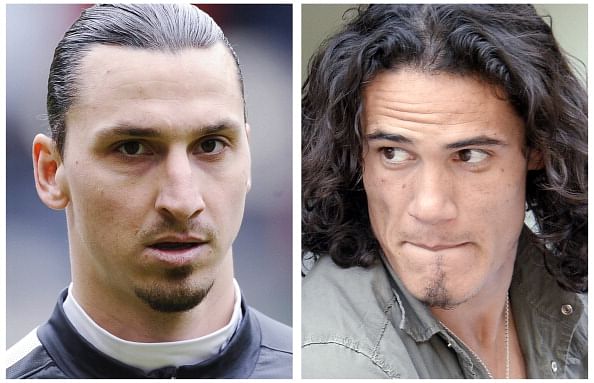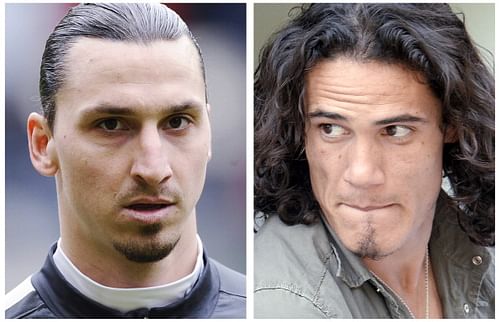
PSG: The Ibrahimovic and Cavani conundrum

Zlatan Ibrahimovic (L) and Edinson Cavani
In a busy, yet bizarre, transfer week Edinson Cavani has put pen to paper and has moved to PSG for €63 million. His addition to an already impressive PSG squad poses questions on how the French champions may be set-up on the field next season. The issue is mainly focused on if he can work well with Zlatan Ibrahimovic, who scored 30 goals in Ligue 1 last season but it goes further beyond that.
PSG settled with a 4-2-2-2 formation last season under Carlo Ancelotti, after the Italian tried a number of different systems reminiscent of his time at Chelsea. The narrow “Christmas tree” tried initially worked for a while, as PSG escaped with a couple of narrow winning results but the home defeat through the midway of the season to Saint-Etienne showed the shortcomings of the system.
The change to 4-2-2-2 with Ibrahimovic partnering Lavezzi or Menez on top has seen them performing well in the second half of the season. Although the Swedish striker has exceptional scoring record, he is more of a deep-lying forward, comfortable dropping deep into the midfield and creating chances for players around him. Indeed according to Whoscored, he has created 19 clear-cut chances for his team mates last season. On the other hand, Cavani converted 21 clear-cut chances last season proving his lethal prowess in front of goal. On paper, this should be the ideal combination you would want in your team.
The problem is that Cavani is that he is the same type of forward as Ibrahimovic. Although his goals show his calibre, it’s Cavani’s work rate which is more impressive when pitted against other top forwards. The Uruguayan is extremely industrious and helps his team out in defence not allowing opponents to play from the back. This functional role was ideal for Napoli’s 3-4-3 system where they would sit back, allowing opposition time (but not space) on the ball and when they lose it, be devastating on counter.
Cavani’s work-rate meant that Ezequiel Lavezzi – another extremely functional player – could stay wide and make direct runs at the goal. In PSG’s two striker formation, Cavani and Ibrahimovic’s working areas on the pitch would be the same. Both drop deep to collect the ball, possess the aerial ability as well as technical skill on the ball and are unhappy when isolated from the play. It’s as if you were to find a replacement with Ibrahimovic’s set of skills right now, Cavani is as close as you can get.
Compounding to this problem is PSG’s managerial change. While Ancelotti’s Italian roots explain his favour towards narrow formations, Laurent Blanc is a modern manager who favours an even balance of players on the field. Although he has been out of the game since France’s exit in Euro 2012, his stint with the national team and earlier with Bordeaux gives us an idea of his philosophy.
Although he was sacked after Euro 2012 in which France were dark horses, they went on an 21 match unbeaten run before that. Before that for three seasons, he transformed Bordeaux into one of the best defensive units in Europe. Both France and Bordeaux primarily played with 4-2-3-1 system, dominating the midfield and passing from the back. If Blanc sticks to his philosophy, there would be place for only one of Ibra or Cavani in the starting 11 or one of them has to play the No.10 role connecting midfield and attack. Which takes us back to the original point that both aren’t comfortable when isolated upfront.
That’s not to say that Cavani and Ibrahimovic can’t work together. Both have enough talent and skill set to merit their place in the starting 11 and combine well. Their physical presence upfront means PSG have the aerial ability against any defence in Europe. Both of them can drop deep into midfield and draw defenders into awkward positions which helps the wide players like Lucas Moura and Lavezzi to prosper. But this is a big “if”.
In fact, one of Laurent Blanc’s biggest criticisms is that although the team coped well to recover after the 2010 World Cup embarrassment, he never really found his starting 11. When France quietly went through their 21 match unbeaten run, he constantly experimented with the team’s formation using 4-2-3-1 and 4-3-3 and decisions like using Malouda in the midfield trio gave an impression that he wasn’t really sure of what he was doing. France eventually bowed out of Euros for the same reason, they had too many options but never really found the winning combination. If PSG are to succeed domestically as well as in Europe next season, Blanc has to make sure he doesn’t make the same mistake this time.